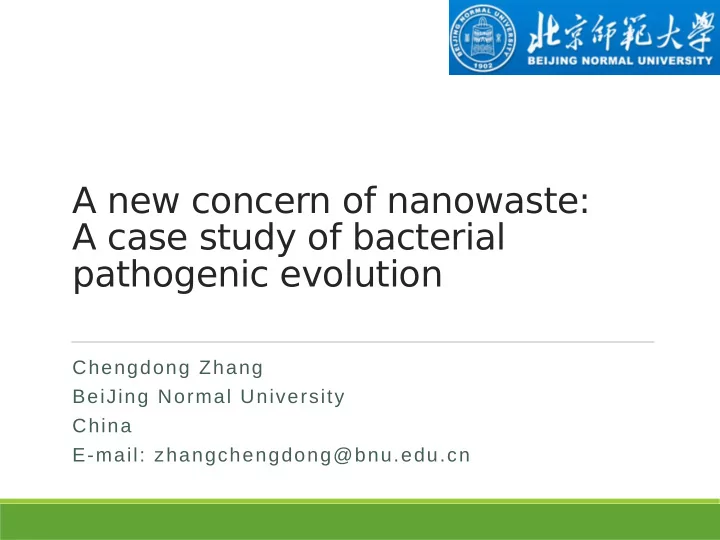

A new concern of nanowaste: A case study of bacterial pathogenic evolution Chengdong Zhang BeiJing Normal University China E-mail: zhangchengdong@bnu.edu.cn
Background: Triclosan Applicatio T oxicity n Pathogenic selection/evolu tion
Background: Triclosan Zhang* et al., Environ Sci T echnol, 2019
Background: nanosilver One of the promising substitutes is silver nanoparticle (AgNP). Potentially used in many daily life products for antimicrobial purpose. Increase of production, environmental release, ecological risk
Background: nanosilver AgNP concentration in the environment (Anal. Chem., 2013)
Key Questions & Hypothesis Environmental exposure: low dose & long term is there selection on anti-silver microorganism? Will there be cross-resistance to antibiotics? Mechanism? (ACS Nano, High dose, acute 2017) toxicity
Experimental AgNP characterization (Ag + or nanoparticle?) E coli was exposed to 0.02 μg/mL (1/100 MIC 50 ) of AgNP, for more than 200 subcultures (> 1yr). Monitor the changes in phenotypes (i.e., morphology, growth rate, change of minimal inhibition concentration MIC) illustrate the adaptive mechanism (based on transcriptomic and genomic analysis) Potential cross-resistance to antibiotics
Results and discussion • No obvious morphological change • After acclimation, no growth inhibition in response to ½ MIC
1 st question: What are the working species? Silver ion or nanoparticles?
In water In medium • few freely dissolved ions < • Protein Coated 0.1% • Aggregate
2 nd question: anti-silver ion or nanoparticle? Mechanism?
• T olerance to both Ag + and Ag nanoparticle
Anti- Silver ion Anti- nanoparticle Extracellular Ion effmux precipitation pump
• No anti- nanoparticle effect
• Anti-silver ion via Cu-effmux pump
Ion particle • Enter cell via Trojan-horse mechanism • Release ion inside cells • Develop adaptive response in order to eliminate intracellular silver ion
3rd question: Is there co-selection on antibiotic tolerance? Mechanism?
Cell wall DNA/RNA synthesis Protein Protein synthesis synthesis
• Over-expression of multidrug resistance genes (efflux pump, porins).
Multi-species tolerance: Ag + , Ag nanoparticles, Cu 2+ H 2 O 2 , Mn 2+ multi-drugs
• High ROS content in adapted cells • Without NP exposure, ROS content increase ~50% in adapted cells relative to wild type. • No ROS production under acute exposure to 0.02 mg/L AgNPs • High content of ROS after chronic exposure
• Changes of physiological status
Oxidative stress induced DNA instability Enriched functions potential related to virulence development: High mutation rate Mutations at : copper efflux pump general stress DNA repair (SOS) antioxide
Conclusions Bacterial evolution was observed upon chronic exposure to low dose of AgNP. Co-development of multi-species tolerance (metal ions, nanoparticle, antibiotics, and oxidant) due to intracellular ROS stress. Stress-related DNA instability, and high mutation rate. Are we making a future superbug? TCS AgNP tranquil intense
Acknowledgement $$$ from NSFC (21777077) ; Graduate students: Mingzhu Li, Jing Li, Jing Sun
ROS stress in evolved cells Multi species tolerance DNA instability
Recommend
More recommend